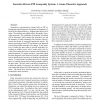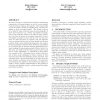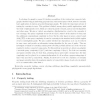162 search results - page 27 / 33 » The Induced Disjoint Paths Problem |
TDSC
2010
13 years 2 months ago
2010
Network survivability is the ability of a network keeping connected under failures and attacks, which is a fundamental issue to the design and performance evaluation of wireless ad...
ICPP
2007
IEEE
14 years 1 months ago
2007
IEEE
– Anonymous communication systems built on P2P infrastructures using anonymity forwarders are frequently affected by the churn problem, i.e. frequent joins and leaves of nodes. T...
TOC
2008
13 years 7 months ago
2008
For an integer h 1, an elementary h-route flow is a flow along h edge disjoint paths between a source and a sink, each path carrying a unit of flow, and a single commodity h-rout...
STOC
2004
ACM
14 years 7 months ago
2004
ACM
We prove an (lg n) cell-probe lower bound on maintaining connectivity in dynamic graphs, as well as a more general trade-off between updates and queries. Our bound holds even if t...
STACS
2007
Springer
14 years 1 months ago
2007
Springer
A coloring of a graph is convex if it induces a partition of the vertices into connected subgraphs. Besides being an interesting property from a theoretical point of view, tests f...



